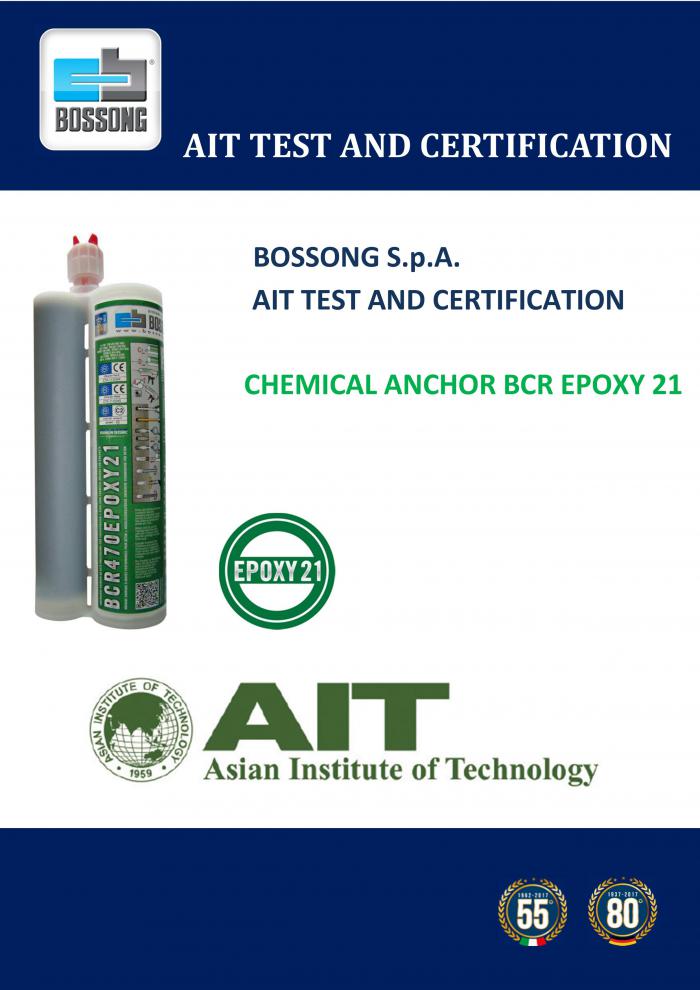
Bossong S.p.A. è lieta di comunicare che la nostra resina BCR EPOXY 21 è stata testata presso l’istituto AIT all’interno del laboratorio di Ingegneria Strutturale.
L'Asian Institute of Technology promuove il cambiamento tecnologico e lo sviluppo sostenibile nella regione dell'Asia e del Pacifico attraverso l'istruzione superiore, la ricerca e la divulgazione. Fondata a Bangkok nel 1959, AIT è diventata una delle principali istituzioni regionali post-laurea e collabora attivamente con partner del settore pubblico e privato in tutta la regione e con alcune delle migliori università del mondo.
Nello specifico i test che sono stati effettuati sono i cosiddetti pull-out test, sia su barre filettate che su barre ad aderenza migliorata.
Il test di pull-out non è altro che un test in cui dopo aver installato l’ancorante chimico all’interno dell’elemento di calcestruzzo, questo viene messo in trazione fino a quando si arriva alla rottura dell’elemento di calcestruzzo oppure allo sfilamento della barra.
Il test di pull-out può essere effettuato con due set-up di prova differenti. Durante il test infatti l’elemento di calcestruzzo può essere confinato oppure non confinato.
Nel momento in cui si effettua una prova confinata si previene la rottura per cono di calcestruzzo, e quindi è possibile osservare lo sfilamento dell’ancorante oppure la rottura lato acciaio. Generalmente si utilizza questo tipo di set-up nel momento in cui si vuole ottenere il valore di adesione del prodotto.
Nel caso di test non confinato invece si ha che l’elemento di calcestruzzo può arrivare alla rottura per cono di calcestruzzo.
Nel caso di profondità di affondamento ridotte e valori di adesione del prodotto elevati si ha infatti che in genere la rottura tipica risulta essere proprio quella per cono di calcestruzzo.
*****************************************************************
Bossong S.p.A. is pleased to report that our BCR EPOXY 21 resin has been tested at the AIT institute by the Structural Engineering laboratory.
The Asian Institute of Technology promotes technological change and sustainable development in the Asia-Pacific region through higher education, research and dissemination. Founded in Bangkok in 1959, AIT has become a leading regional post-graduate institution and actively collaborates with public and private sector partners throughout the region and with some of the world's best universities.
Specifically, the tests that have been carried out are the so-called pull-out tests, both on threaded rods and on reinforced bars (rebar).
The pull-out test is nothing more than a test in which after having installed the chemical anchor inside the concrete element, this is put in traction until it comes to the breaking of the concrete element or to the extraction of the bar.
The pull-out test can be performed with two different test set-ups. In fact, during the test the concrete element can be confined or non-confined.
When a confined test is carried out, breakage by concrete cone is prevented, and therefore it is possible to observe the pull-out of the anchor or the failure of the steel element. Generally, this type of set-up is used when you want to obtain the product's adhesion value.
In the case of a non-confined test, on the other hand, the concrete element may break into a concrete cone.
In the case of reduced setting depth and high adhesion values of the product, it is in fact generally found that the typical failure is precisely that of concrete cone.
